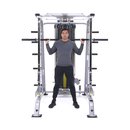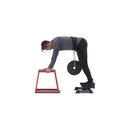“Leg day”—the very phrase conjures up images of nausea, days of hobbling, and legs that feel like jello. The feelings may be universal, but bodybuilders looking to annihilate legs have countless workout options at their disposal. While most workouts start with some variation of the squat—widely acclaimed as the best lower-body movement—exercise choice, foot position, and advanced training techniques all allow you to emphasize one particular area of the legs over others. That’s great if you want to thicken up your quads, fill out your glutes, or beef up your hamstrings because of a weakness—or simply because you want to prioritize an area for a length of time.
Each of the seven leg workouts below has a different focus. Find one that suits your needs for the next 4-8 weeks before switching to another specialized program. Or simply follow a solid overall mass-building plan like the one listed under Goal 1.
While we can provide any number of formulas for advanced leg growth, you’re still on your own when it comes to generating the intensity to survive a high-octane workout and withstanding the pain. Nail those last two factors and you’ll leave your wheels no choice but to grow.
Goal 1: More Overall Leg Mass
Mass-building comes with a set of rules. That means starting your workout with the most challenging exercises and heaviest loads, hitting the thighs from a variety of angles, keeping the volume (number of total sets and reps) high, and training to muscle failure.
Altering your foot placement on the leg press allows you to recruit leg musculature in slightly different ways. Putting your feet up higher on the sled shifts some of the emphasis from the quads to the hams and glutes because a greater degree of hip flexion/extension is taking place. Also, don’t shortchange the depth of your knee bend—which should reach 90 degrees—by going too heavy—that also limits glute and hamstrings activation. Unless you’re following a pre-exhaust routine, save the single-joint movements for last.

Mass-building comes with a set of rules. That means starting your workout with the most challenging exercises and heaviest loads, hitting the thighs from a variety of angles, keeping the volume (number of total sets and reps) high, and training to muscle failure.
The workout follows a reverse-pyramid protocol, which allows you to take more total sets to muscle failure. As the rep target goes up, be sure to lighten the weight commensurately. The workouts target four muscle groups: quads, glutes, hamstrings, and calves. To shorten the workout, you could eliminate exercises for calves, hamstrings, or both; if so, hit calves and hammies on a different training day.
Notes
- Do as many warm-up reps as you need, but never take them to muscle failure.
- Choose a weight that allows you to reach muscle failure by the target rep listed.
- If you have a spotter, do a few forced reps on your 1-2 heaviest sets of each exercise.
Goal 2: Greater Leg Definition
Simply doing more work with light weight for high reps isn’t enough to get you lean. To keep your metabolism high, you still need that stimulus for building and keeping muscle size. That will help boost excess post-exercise oxygen consumption (EPOC), which roughly translates to the number of calories you burn after your workout is over.

Simply doing more work with light weight for high reps isn’t enough to get you lean. To keep your metabolism high, you still need that stimulus for building and keeping muscle size.
That’s why the first exercise here is done straight-sets-style, but the rest of the workout consists of supersets with multijoint exercises, along with reduced rest periods and a high volume of work.
Notes
- Do as many warm-ups as you need, but never take them to muscle failure.
- Choose a weight that allows you to reach muscle failure by the target rep listed.
- The first exercise is done with heavier weights, which is key for maintaining muscle tissue and keeping your metabolism high during periods of dieting.
- Strive to keep your rest periods short and your heart rate up, making this as much a cardio activity as a muscle-building one.
Goal 3: Starting Strong
Learning to squat can be a challenge, which is why the simple goblet version is a great place to start. The idea here is to learn and practice movement patterns before loading them with heavier weights or graduating to more complex moves.

The idea here is to learn and practice movement patterns before loading them with heavier weights or graduating to more complex moves.
This workout is largely machine based, which allows for a more controlled introduction to weight training. As your coordination improves and your muscles strengthen, move on to more challenging free-weight moves and heavier loads.
Notes
- Do as many warm-ups as you need, but never take them to muscle failure.
- Choose a weight that allows you to approach muscle failure by the target rep listed, but stop a rep or two short. Proper technique starts to give way when you push to muscle failure, and your priority here is learning good form.
- Start the workout with more challenging multijoint movements. Because they recruit a larger amount of muscle mass, rest periods are correspondingly longer.

























